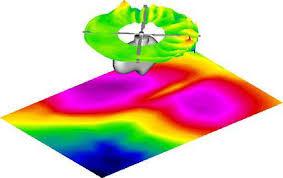eVTOL Noises Off (Or at Least Significantly Quieter)
Getting eVTOL technologies off the ground will be easy compared to getting communities to accept the noise they generate.

As eVTOLs navigate the technological mazes and regulatory hurdles needed to make advanced air mobility (AAM) a viable, safe, and profitable means of transportation, one of the key obstacles the industry faces is noise.
The rotors currently being used and those in development for UAVs (uncrewed air vehicles, AKA drones) and passenger- and cargo-carrying aircraft are noisy.
Historically, the communities in which UAVs will operate are averse to excessive noise. To help mitigate the racket of rotors, scientists at Embry-Riddle Aeronautical University studied options to dampen the volume eVTOLs generate.
Dr. Vladimir Golubev, Dr. A.S. Lyrintzis, and Dr. Reda Makbadi, working with their research assistant, Samuel Afari, published the results of their study, “Review of Control Technologies for Quiet Operations of Advanced Air Mobility,” in the February 16, 2023 issue of Applied Sciences.
Vertical, Vertiports, and Volume
The challenges and options available to abate the noise fall into several categories: passive control technologies applied in reducing tonal and broadband noise; multidisciplinary optimizations (MDO) – balancing the noise reduction against the performance; and active noise control (ANC) technologies.
Passive control technologies include tonal noise reduction by ducting; stacking, blade count and spacing, and phase control.
Ducting with acoustic absorption materials – both perforated and non-perforated reduced noise, but also reduced performance efficiencies between 10% and 20%. Stacking propellers decreased overall propulsive efficiency in the top propellers but increased it in the bottom propellers.
Blade count and spacing were also studied. Increasing the number of blades reduces tonal noise by 10dB, but it also increased the frequency of the noise. If the blades were unequally spaced, tones were diminished at the blade-passing frequency (BPF). Depending on the rotational rate, a smaller diameter propeller was also found to reduce noise.
Stacking propellers seemed to be a net-zero gain proposition. Two propellers stacked on top of each other increased propulsive efficiency. The front (or top) propeller lost thrust and propulsive efficiency while the bottom propeller gained thrust and propulsive efficiency.
Phase control promises to be an effective means of noise reduction. By modifying the overall directivity of the blade passage frequency, in certain circumstances, noise reductions up to 28.6 dB can be achieved.
Serrated edges – on either the leading or trailing edge of the blades can also have a positive effect on noise reduction, but it depends, to some degree, on what phase of the flight an operator is executing, and the size and depth of the serrations.
To balance the noise reductions achieved by passive design changes while mitigating performance decreases, a multidisciplinary optimization (MDO) approach is suggested. Using algorithms to minimize or maximize specific function sets, complex systems can not only achieve optimized performance of the individual disciplines, but also of the multiple disciplines interacting with each other.
Active noise control technology can also positively affect noise reduction by using zone control, on-blade actuation, active tonal noise control during approach, and calculation of distributed array of loading actuators.
The Zone of Silence
Much of the eVTOL flight operations under consideration will take place in, or near, urban and suburban environments – heavily populated areas where the local communities must approve such operations. Those communities may be reluctant to trade some travel conveniences for the roar of eVTOL rotors as they take off and land in their neighborhoods.
The study’s authors posit that machine-learning might be the key to noise reduction for UAM/AAM operations. Machine learning could quickly analyze the sources and types of radiated noises and then develop a reduce-order model (ROM) and predict – in real time – which anti-noise optimized signals will be effective. Time – and further study of the issues – will tell.
Subscribe to AeroCar Journal today, (It’s free for a limited time!). Follow us on Facebook, Twitter, and LinkedIn.
#eVTOLs, #UAM, #AAM #rotorcraft


